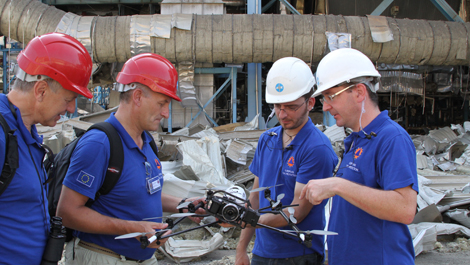Natural and man-made disasters are growing in frequency and intensity. In December 2011 the Commission adopted a new legislative proposal which aims to reinforce the EU's disaster management.
The revised legislative proposal suggests creating a European Emergency Response Capacity, moving from the current ad hoc arrangement to a predictable and reliable system that allows for good planning. Prevention and preparedness actions will be equally integrated in the EU Civil Protection Mechanism.
Another key proposal is the setting up of a European Emergency Response Centre (ERC) which will be responsible for the coordination of the EU's civilian disaster response. The ERC will ensure that Member States are fully informed and able to decide about the provision of the most needed assistance.
The European Commission is proposing a better, faster, and more efficient EU response to disasters.
At present, the EU can draw upon a wide range of instruments when responding to major disasters. These include the use of Member States' civil protection assets through the EU Civil Protection Mechanism and the provision of EU humanitarian assistance to victims of natural disasters outside the EU.
The value of such instruments is widely acknowledged. But the increase in the frequency and intensity of major disasters (both natural and man-made) means that the Commission has decided to strengthen existing arrangements.
In 2010 alone, Europe and its immediate neighbours experienced a series of particularly severe disasters. These ranged from flash floods and severe storms in Western Europe, large-scale floods in Central Europe, volcanic ash clouds after the eruption in Iceland, to unprecedented forest fires in Russia. Haiti and Pakistan also suffered from major natural disasters. 2011 was not better encountering the devastating earthquake and subsequent tsunami in Japan and the explosion in the Cyprus naval base, both of which resulted in the loss of lives and widespread destruction.
Against this background, the European Commission in 2010 adopted the Communication "Towards a stronger European disaster response: the role of civil protection and humanitarian assistance". On its basis in December 2011 the European Commission adopted the new legislative proposal.
It sets out ways in which the EU's immediate response to natural and manmade disasters (excluding armed conflicts) can be strengthened. In particular, it proposes the creation of a European Response Capacity which aims at:
- The establishment of a voluntary pool of experts and specialized equipment available for immediate deployment as part of a collective European intervention;
-
The setting up of the Emergency Response Centre (ERC), providing for an improved service with better planning and better coordination when a crisis hits;
-
The simplification and strengthening of transport arrangements for a faster immediate deployment of EU assistance;
-
The enhanced cooperation on the advanced planning of European disaster response operations through developing reference scenarios, mapping Member States' assets and drawing contingency plans;
-
The increased investment in joint training and in cross border exercises;
-
The cooperation with Member States to develop an EU-wide overview of natural and man-made risks.
The European Emergency Response Centre will be a 24/7 response centre created by merging the humanitarian aid (ECHO) and civil protection (MIC) crisis rooms. The Centre will serve as a platform for a more efficient EU response by collecting information on disasters, monitoring hazards, preparing scenarios and coordinating the EU's disaster response efforts. It will also have direct links with the Civil Protection and Humanitarian Aid authorities of Member States allowing it to process all in-kind assistance.


 [6 KB]
[6 KB]  [98 KB]
[98 KB]  [65 KB]
[65 KB] 

